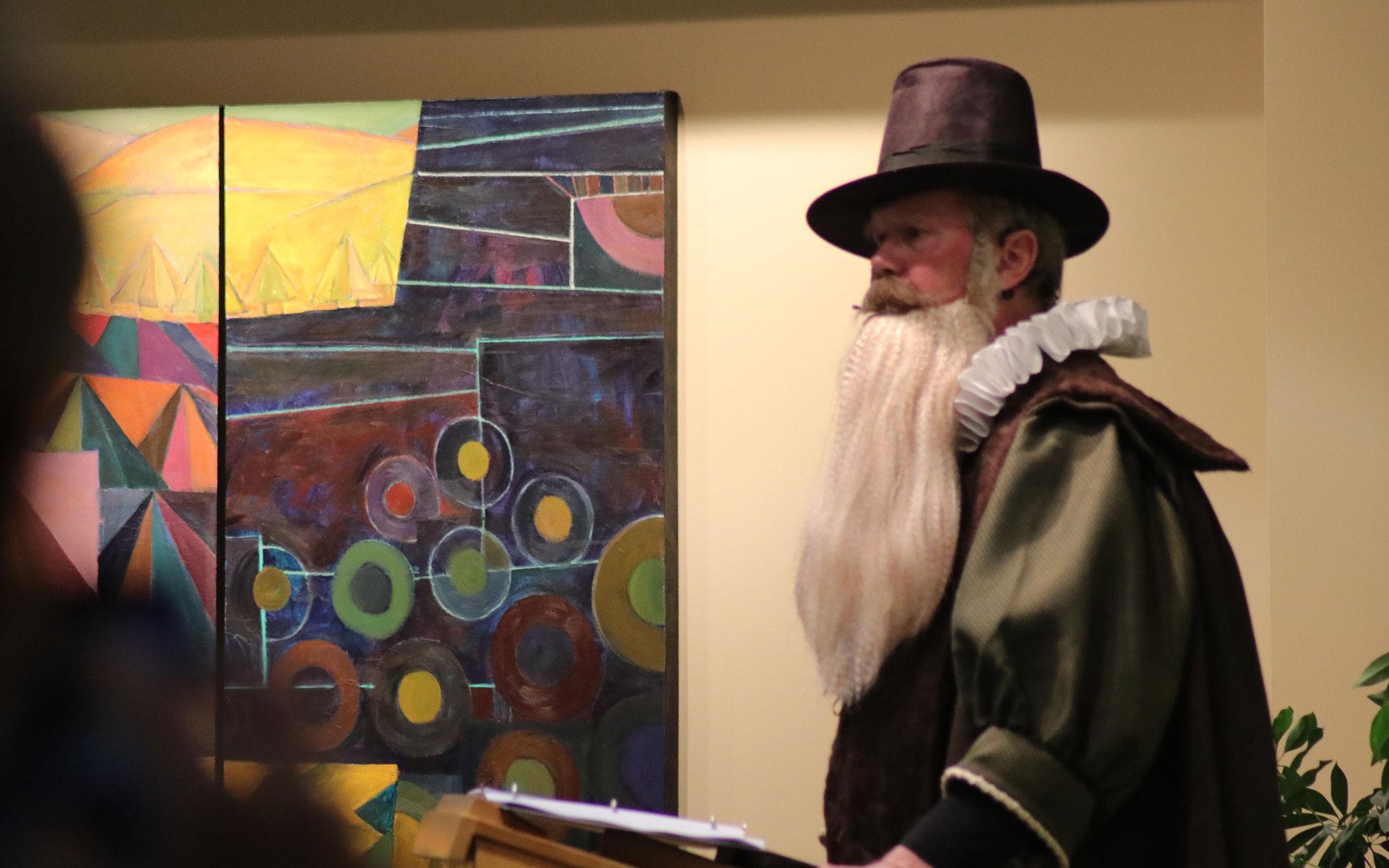Dressed in a tall hat, dark pastor’s robe, and ruffled shirt, and sporting a long white beard, Don Sinnema greeted attendees at this fall’s Synod of Dort Commemorative Conference in the Calvin Theological Seminary auditorium.
Sinnema, a retired Trinity Christian College professor, opened the two-day conference that marked the 400th anniversary of the synod—a wide-ranging gathering of Reformed church leaders—by explaining important aspects of the synod and how it helped shaped the Reformed faith.
He introduced himself by saying, “I am the Rev. Johannes Bogerman, president of the Synod of Dort, the most significant synod of the Reformed tradition. I was there at the helm. This venerable synod happened four years ago, but it is still fresh in my mind.”
His presentation, including about 100 PowerPoint slides, recalled for his audience the old island city of Dordrecht in 1618–1619. He discussed the agenda and circumstances of the Synod of Dort, which drew Dutch church delegates, theologians from eight foreign territories, Dutch political delegates, and others. “This was a national synod with an international character,” he said.
Chiefly, he said, “this meeting was held to settle the Arminian controversy about predestination that had been agitating in the Netherlands for about 20 years.”
Based on the teachings of Jacobus Arminius, these teachings boiled down to five points: free will or human ability, conditional election, universal redemption or general atonement, resistance to the Holy Spirit, and the possibility of falling away from grace.
Showcasing the synod by wearing colorful period garb was one way Sinnema tried to communicate that the synod was not a dry, dusty meeting over arcane beliefs.
Speaking after Sinnema on Friday afternoon was Paul Fields, curator of the H. Henry Meeter Center at Calvin College, who talked about the translation of the Bible into Dutch.
In the first sessions of the Synod of Dort in November 1618, before the delegates even addressed the Arminian controversy, Fields said, they commissioned a new Bible, the Statenvertaling (States' Translation), which was published in 1637.
Keith Stanglin, professor of historical theology at Austin Graduate School of Theology in Austin, Texas, gave a deeper look at the Remonstrants, the Arminians, in a talk late Friday afternoon.
The day finished with "Song of the Synod," presented by Randall Engle, a Christian Reformed pastor who spoke about the role church organ music had in the Dutch Republic at the time of the synod.
On Saturday morning, Fred van Lieburg, professor of religious history in the Faculty of Humanities at the Vrije Universiteit (Free University) Amsterdam, gave attendees an overview of the members of the public who attended the synod—where they sat and how they interacted with delegates. He spoke of the tensions that arose when the synod decided to expel the Remonstrants from the meeting.
Dordrecht, he said, was chosen as the site for the meeting because of its synodal tradition. Significant synods were held in 1574 and 1578. "The synod attracted a lot of attention. Dordrecht was really a tourist hotspot in those months. Many people just came to see or attended a part of the meeting in the public gallery,” he said.
Following van Lieburg, Suzanne McDonald, a professor at Western Theological Seminary, addressed the lasting effect the synod has had on the church. On the one hand, the gathering over the years—and the Canons of Dort coming from it―has been framed by some as a dispute over who God does and doesn’t favor for salvation.
But there is much more, and, if you read the entire document, you see that there is a strong pastoral thrust in the canons, she said.
“It may be true that not all will be saved, but only God knows that,” she said. “Reading the Canons we see that the canons show deep concern and pastoral assurance. . . . You read that God’s grasp on us is much stronger than our feeble grip on him.”
The gathering wrapped up with a panel discussion featuring Kathy Smith from the Calvin Institute of Christian Worship; Matthew Van Maastricht, a Reformed Church in America pastor in Altamont, N.Y.; and Karin Maag, director of the H. Henry Meeter Center.
Van Maastricht spoke of using the Canons of Dort in his sermons, but first preaching about the positive things such as the “unspeakable comfort of God’s grace.” Also, he said, by looking at the history we can learn how factions of God’s people can gather to resolve differences.
Kathy Smith discussed the Synod of Dort’s development of a revised church order and highlighted the lasting significance of this church order for Reformed worshiping communities. Also, she said, in spite of the reputation the synod has had for doctrinal statements that seem harsh or cruel, she knows of a church planter who is using the Canons of Dort as an example of an ancient Christian text that “does speak to us and has wisdom for today.”
About the Author
Chris Meehan is a freelance writer and commissioned pastor at Coit Community Church in Grand Rapids, Mich.

